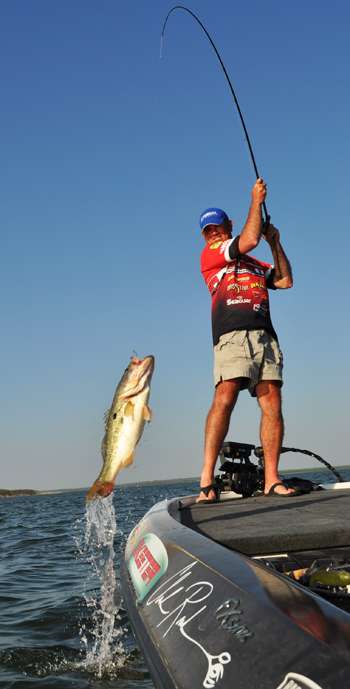
What goes into your Carolina rig can be the difference between success and failure. Simply knowing how to make a rig isn't going to put fish in the boat.
Elite Series pro Clark Reehm is a technician. He prides himself on the scrutiny he puts all of his equipment through. If you spend any time with him in a boat, you'll hear this refrain several times:
"There are only so many things that you have control over during the course of a day on the water, so you need to control all the elements that you can to increase your chances of success. A lot of it has to do with your equipment," he says. "There are several ways to optimize your set to get the best hookup-to-landing ratio possible."
Reehm placed second to Todd Faircloth in the 2008 Elite Series event on Lake Amistad by dragging a Carolina rig. It wasn't just any rig, though. He's gone through many rod/reel/line/weight combinations and has since found a keeper. Here we'll detail every part of his setup.
Rod and reel
Rod selection may be more critical for Carolina rigging than any other technique. There is a lot going on in a Carolina rig rod. You need a rod that can bomb a rig a long way, one that can discern a rock from a fish in 40 feet of water and, lastly, your rod needs to be able to drive a hook through the jaws of a big bass that might be 40 yards away.
"I like a rod to be longer — 7 or 7 1/2 feet — because you need to be able to move a lot of line on the hook set," Reehm says. "Your rod needs backbone, first and foremost. This will drive the hook home. Secondly, you need some tip to it. This will let the rod work for you on the cast as well as when you're feeling out the bottom."
Reehm's preferred rod is a Dobyns Champion model 764, a 7-foot, 6-inch, four-power rod. It has the right qualities to work a rig deep, shallow, near and far without sacrificing anything on the cast.
The reel you choose for Carolina rigging is equally as important. Carolina rigs are usually thrown a long way and find themselves in deep water. For these reasons, you need a reel that takes up a lot of line quickly to ensure you get a good hook set.
Line and leader
Pivotal to a rig's success are the line and leader. These are your connections to the bait and, ultimately, the fish. Like the other categories, there are plenty of options available.
"Of the three kinds of line, I don't use monofilament, you just don't feel as many bites," he says. "Plus, it's the stretchiest and most prone to fraying of the three. A lot of folks use braid, but I don't. You're going to feel a lot of stuff on the bottom that may feel like bites when they're actually not. You'll end up setting the hook on a lot of branches and rocks. The other thing about braid is that, since it doesn't have any stretch, you'll bust your leader if you have a decent hook set."
For these reasons, Reehm uses fluorocarbon line. It's a good compromise. He uses it for 90 percent of his fishing.
He uses one of two setups. The first is 15-pound-test Seaguar AbrazX when there is little or no cover on the bottom, 20-pound-test AbrazX if there is a normal amount, and 25-pound test if there is nothing but nasty stuff on the bottom or big fish in the area.
As for leader length, a 2 1/2- to 3-foot leader is ideal for most scenarios. When the cover is heavier or the bottom rougher, a shorter leader may be better. Around grass and in clearer water he'll use a 3-footer.
"With a longer leader, you're sacrificing some hook setting power. That's why you need a longer rod," he says.
For material he uses Blue Label leader material from Seaguar. It's pure leader-quality fluorocarbon, so is a little harder and stronger than your average fluorocarbon. His rule of thumb is to go one size down from his main line. For example, if he's using 20-pound-test main line, he uses 15-pound-test leader.
Reehm advises that if you're dead set on using braid for main line, use monofilament for a leader as it offers some shock absorption.
Check back soon for part 2 of this series on Carolina rigging, where Reehm covers hooks and sinkers and other extras that make the rig more productive.




